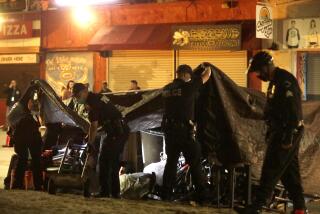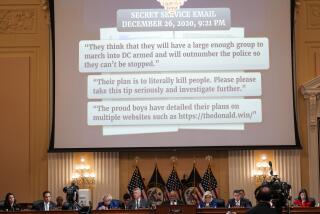Reports of Black Plans for Violence Cited; 19 Slain : Feared Death Trap, S. Africa Officer Says
- Share via
JOHANNESBURG, South Africa — The policemen who fatally shot 19 blacks near Uitenhage last month expected to be trapped and killed as part of a “campaign of terror” against the South African government and its supporters, their commander told a judicial inquiry Tuesday.
Lt. Col. Frederik A. Pretorius, the Uitenhage divisional commander, said the police believed on the basis of intelligence reports that black radicals had planned a campaign of increasing violence to force all black town councilmen to resign and to drive the police completely from the townships outside Uitenhage.
The plans, according to Pretorius, included fiery barricades at the entrance to each black township, ditches and camouflaged pits in which to trap police vehicles, firebomb ambushes of police patrols and continuing attacks upon town councilmen, widely viewed in the black community as collaborators with the white regime.
The campaign, Pretorius testified, was to begin with a general strike called for the Port Elizabeth-Uitenhage industrial area to protest police handling of earlier unrest, as well as economic issues.
For this reason, he had ordered policemen on riot duty to be armed with military assault rifles and shotguns with buckshot, though squad leaders were free to draw tear gas, rubber bullets and other non-lethal weapons if they wished.
Pretorius admitted that he authorized the use of buckshot instead of the lighter shotgun cartridges he had been told to use by police headquarters, and that his orders to equip each armored car with rifles and shotguns “anticipated” permission from his superiors.
The commander of the Uitenhage riot squad, Maj. Daniel Blignaut, testified earlier that he had proposed the use of heavier weapons because tear gas, rubber bullets and birdshot were no longer effective against “aggressive groups of blacks.”
Black militants, Blignaut said, regarded the birdshot wounds as status symbols, evidence that they had been in the front lines of the protest.
When police were armed with assault rifles and buckshot on March 15, six days before the Uitenhage incident, and no longer used tear gas and rubber bullets for riot control, blacks became “more fearful,” Blignaut testified, “whereas in the past they would have stoned police vehicles without hesitation.”
On March 21, when two police squads in armored cars confronted about 4,000 blacks on the road outside Uitenhage, marching to the funerals of three victims of earlier unrest, the police opened fire with pistols, shotguns and assault rifles at virtually point-blank range, killing 19 and injuring 35 others.
A Supreme Court Justice, Donald D. V. Kannemeyer, was later appointed by the government to conduct an independent judicial inquiry into the incident. He has heard about 10 days of testimony and will sit for at least two more weeks.
More to Read
Sign up for Essential California
The most important California stories and recommendations in your inbox every morning.
You may occasionally receive promotional content from the Los Angeles Times.













